Lifestyle
The best West Coast travel spots, according to readers
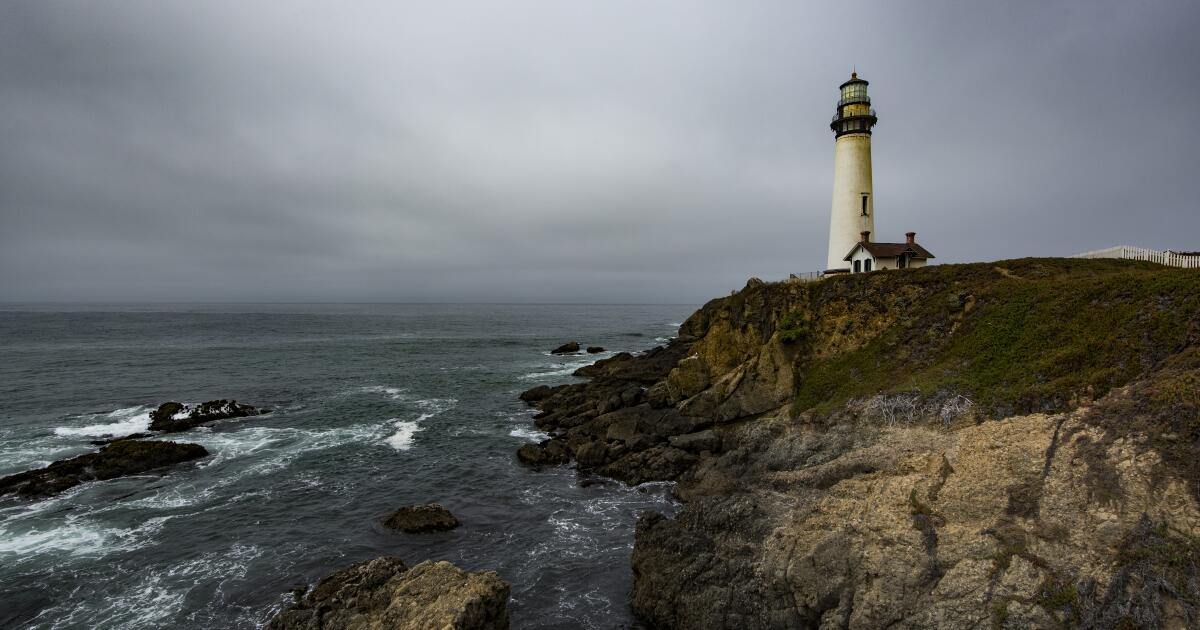
Sometimes 101 is just too small a number.
Many readers, having digested our new list of 101 best West Coast experiences, have stepped up to make the case for destinations we left out, from a country road in Malibu to a remote beach town on a Canadian island. We’ve gathered a sampling of them here.
Most of these readers are pitching their hometowns or sharing finds from their own western ramblings, but others are more mysterious.
One reader wrote from a beloved corner of coastal Northern California to say, “I would tell you [where], but then it would be CROWDED.”
Another reader, insisting on anonymity, said he likes living on a boat in Baja Peninsula, looking out at “the world’s biggest aquarium” in the Gulf of California.
Yet another reader described a “magical” spot at Stinson Beach in Marin County, where birders could watch scores of snowy egrets and great blue herons nest. Alas, officials at Audubon Canyon Ranch say, that moment has passed. A campaign of prolonged and increasing harassment by bald eagles has chased the egrets and herons from the Martin Griffith Preserve. As much as we’d sometimes like it to, the West does not stand still.
As the guy who put together the 101 destinations on our list and fretted plenty over which to include, I have to admit that the readers’ choices here are solid, if not downright jealousy-provoking. I hope to see some of these places in coming months.
Meanwhile, they’re arranged here from south to north.
A road in Malibu
In a passage that sounds like it might be the beginning of a novel, Bryan A’Hearn of Los Angeles writes in praise of driving Malibu Canyon Road on a dewy morning after a long evening with an old friend.
A’Hearn: “Our late night — of lousy cards and sips of cheap vodka and orange juice and industry gossip with too many characters and old and new news — crawled into early morning, and a scenic drive seemed appropriate. It was not quite dawn, and the fog in the valley climbed and coiled the hills ahead of us. Sometimes you were caught in the canyon fog, and the road stretched as long as your low beams. Malibu Canyon Road forks onto tree-hooded backroads; there the fog is mist and veils cul-de-sacs with long, flat houses and fancy mailboxes. My old friend mentioned she once baby sat or dog sat or tutored or nannied — you forget, really — a family up here. The sun yawned over the Pacific and the fog began to lift, and we made the descent to Malibu Colony.”
A historic Black town in Tulare County
Students check out the historical information in front of the Hackett House at the Colonel Allensworth State Historic Park.
(Tomas Ovalle / For The Times)
Lisa Fitch of Los Angeles first visited Colonel Allensworth State Historic Park — site of the first California town founded, financed and governed by African Americans — on a neighborhood group field trip. Soon after, she joined the Friends of Allensworth.
The park is a collection of restored and reconstructed wooden buildings, 12 miles west of Delano in the San Joaquin Valley. The 800-acre town was founded in 1908 near a Santa Fe rail route. Its key proponent, Fitch writes, was an educator and Army chaplain named Col. Allen Allensworth, a charismatic leader who had been born into slavery in the 1840s.
After several years of growth, the town faltered and eventually emptied amid a water shortage, the loss of rail service and the death of Col. Allensworth in a traffic accident. The remaining buildings were at risk of demolition in the late 1960s when former resident Cornelius “Ed” Pope launched a campaign to preserve it. Allensworth became a state historic park in 1974.
On June 8 of this year from 10 a.m. to 4 p.m., Fitch writes, “Allensworth will hold a Juneteeth event! Bring a blanket and umbrella and enjoy tours of the refurbished buildings, entertainment and vendors.”
The star of Sequoia National Park
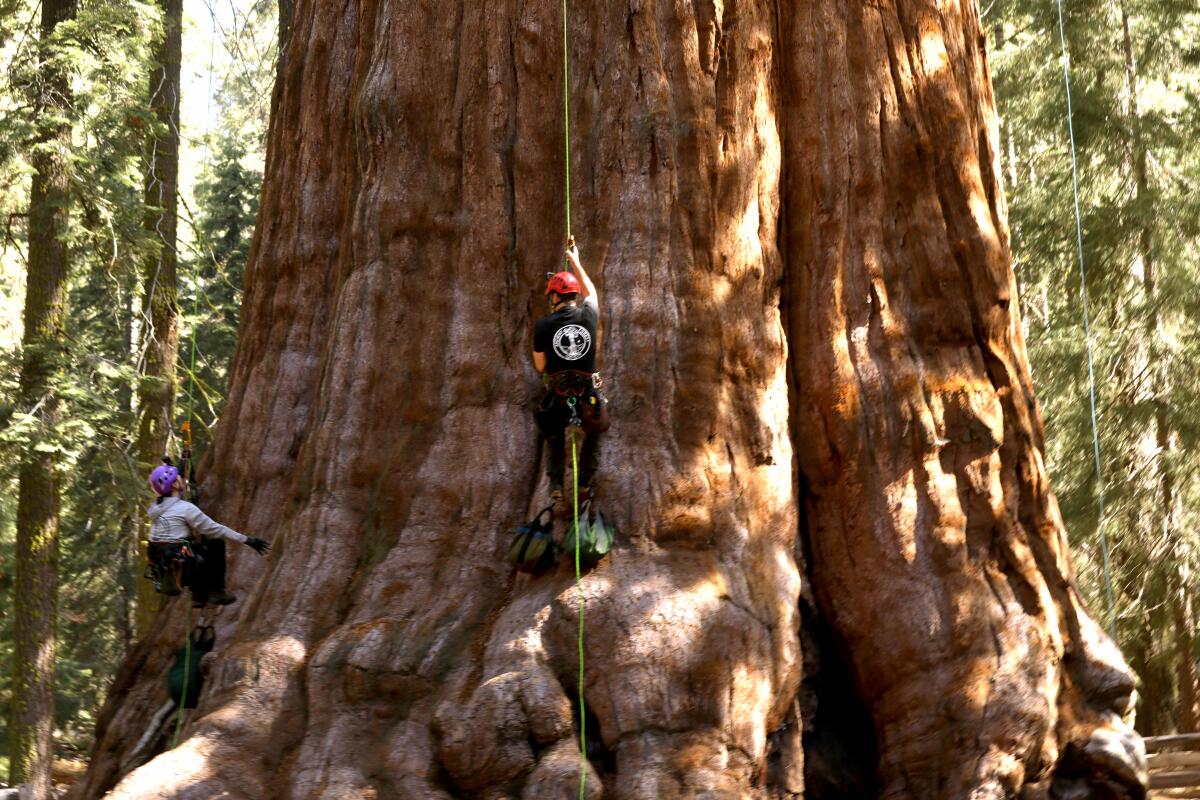
By volume, the General Sherman Tree is the largest known living single-stem tree on Earth.
(Genaro Molina / Los Angeles Times)
“I understand that any list is curated,” begins Eric Gersh of Agoura Hills. Then his note let me have it for overlooking the General Sherman Tree and its companion sequoias in Sequoia National Park. “Still, astonishing that the largest living things on the planet don’t make that list! Too many memories to list, from my own childhood awe to watching my children experience the same wonder at such ancient giants. Yes, you got the redwoods … twice, but no General Sherman amidst the splendor of the Sierras???”
Mea culpa, Mr. Gersh. For the record, the National Park Service affirms that the General Sherman Tree is “the largest in the world at 52,508 cubic feet (1,487 cubic meters),” standing 274.9 feet high with a base circumference of 102.6 feet.
A lighthouse hostel in San Mateo County
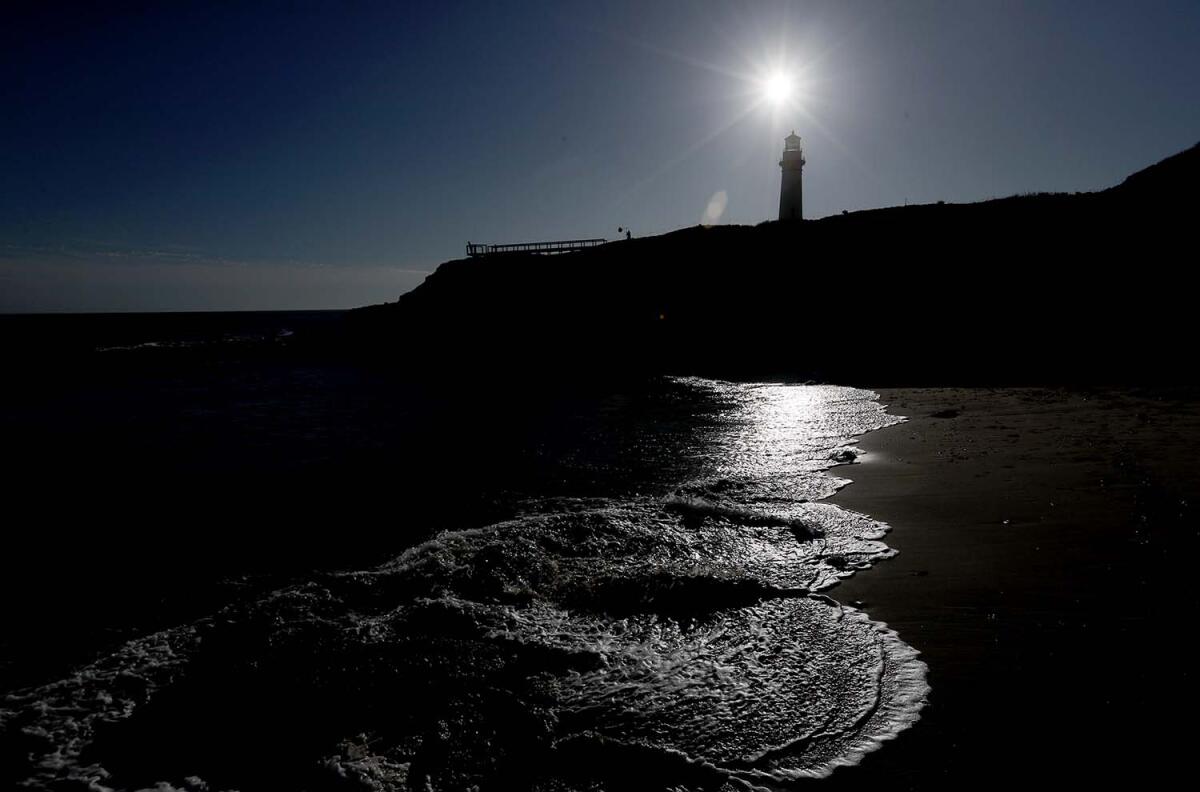
The sun sets behind the Pigeon Point Lighthouse on the San Mateo County coastline.
(Luis Sinco / Los Angeles Times)
Anna Glynne of La Jolla commends the Pigeon Point Lighthouse Hostel, where she stayed last July. Traveling with her sister and her sister’s three children. Glynne booked two nights in a six-person room.
“Our stay was magical,” Glynne writes. “We explored redwood trails in Butano State Park. Her kids spotted elephant seals basking at Año Nuevo State Park. We drove 9 miles to Pescadero for fancy coffees and fresh-baked bread.”
The group’s room had three bunk beds and a private bathroom, with access to a communal kitchen and living area. Other Pigeon Point options include a sunset soak in a hot tub with an ocean view (and often a sea lion soundtrack) or a fort-building session with driftwood on a nearby beach.
Added Glynne: “If you dread camping (like my sister) but still want to explore the California coast on a budget, don’t forget the hostels.”
A theater festival in southern Oregon
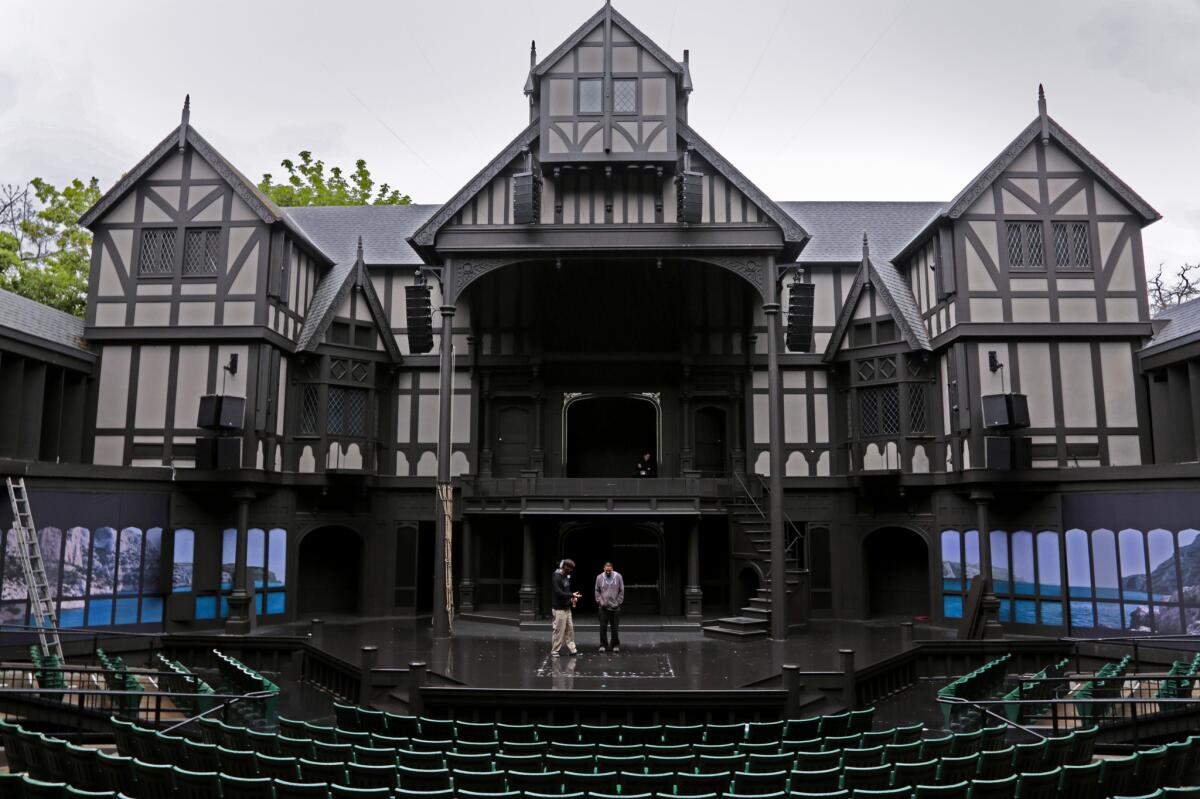
Oregon Shakespeare Festival’s Allen Elizabethan Theatre approximates the open-air theaters of Shakespeare’s day.
(Mark Boster / Los Angeles Times)
Reader Trinity Tracy of Ashland now takes center stage to speak in favor of the Oregon Shakespeare Festival in Ashland.
As Tracy writes, it’s not just Shakespeare and not just a summer thing. The theater festival, which dates to the 1930s, runs March through October, featuring new and traditional plays. Like many theater companies, Oregon Shakespeare has faced struggles since the pandemic, but “it’s really incredible … one of the best and biggest Elizabethan theaters in the world and two other theaters.” In addition, the town of Ashland (not far from Crater Lake) has more than its fair share of restaurants, pubs and lodgings for theatrically inclined travelers.
This year’s Oregon Shakespeare productions include Shakespeare’s “Macbeth,” “Coriolanus” and “Much Ado About Nothing;” along with “Born With Teeth” by Liz Duffy Adams (an imagined encounter between William Shakespeare and Christopher Marlowe); “Lizard Boy,” an indie-rock musical by Justin Huertas; an adaptation of Charlotte Bronte’s “Jane Eyre” by Elizabeth Williamson; and several one-person shows.
A rugged beach in Olympic National Park

Ruby Beach, known for driftwood and stones, is part of Washington’s Olympic National Park.
(Christopher Reynolds / Los Angeles Times)
Joel Kawahara of Quilcene, Wash., suggests Ruby Beach, which is a rugged patch of rocky shoreline, often full of driftwood, in Olympic National Park.
Kawahara: “Ruby Beach is almost completely undeveloped. There is a parking lot, a potty and a trail to the beach. There is no development on the beach; it is simply just as the last wave left it. It is perhaps a little over-visited so crowds are an issue. But if you want to understand the north coast, just stand there and watch the surf and look carefully in the tide pools. Don’t think. Be zen. Or as zen as you can.”
A park in Washington’s Port Townsend
Jeffrey Crocker of Pittsfield, Mass., suggests Fort Worden Historical State Park in Port Townsend, Wash. Crocker calls it “a beautiful place. Where the movie ‘[An Officer and a Gentleman’ (1982) was filmed. Rustic, scenic area at entrance to Puget Sound. Camping, hiking.”
Bellingham, Wash.
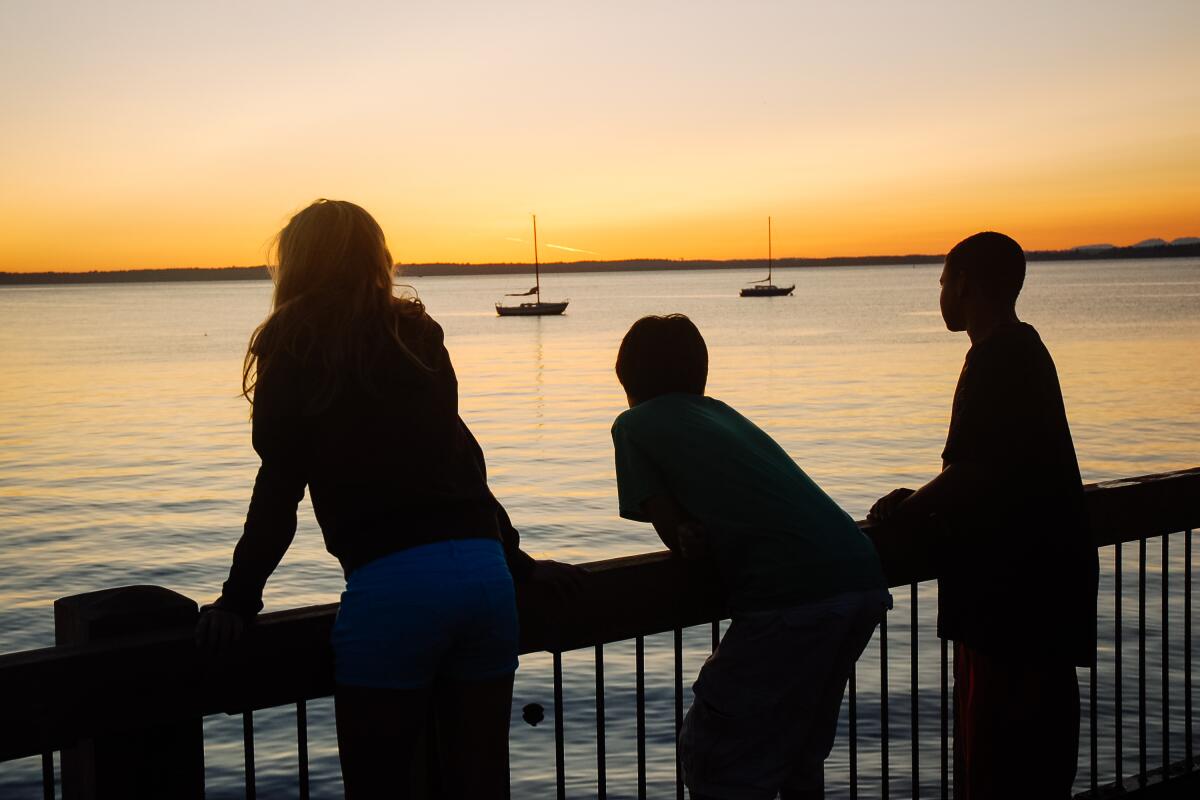
Taylor Dock is a popular waterfront playground for adults and children in Bellingham, Wash.
(Christopher Reynolds / Los Angeles Times)
Michael Grass of Bellingham, Wash., suggests his hometown. (And really, you have to love a place that calls itself “the city of subdued excitement.”)
For best effect, Grass says, arrive by train around sunset, taking in the scenery near Chuckanut Mountain and focusing on the historic Fairhaven neighborhood.
“I work remotely from Bellingham and commute into Seattle via Amtrak Cascades a few times a month,” Grass writes, “and never tire of the waterside train views on the 6 p.m. departure out of Seattle.”
Grass notes that Bellingham’s Amtrak station is in the Fairhaven neighborhood. He recommends eating at Fairhaven Poke, drinking at Southside Bar, checking out the watery views from Taylor Dock, hearing music at Skylark’s and browsing Village Books, “a three-level bookstore and community crossroads known for its book talks, programming and writing workshops.” Or you could head to the cruise terminal and catch a ferry to Ketchikan via the Alaska Marine Highway System.
Among Washington’s San Juan Islands
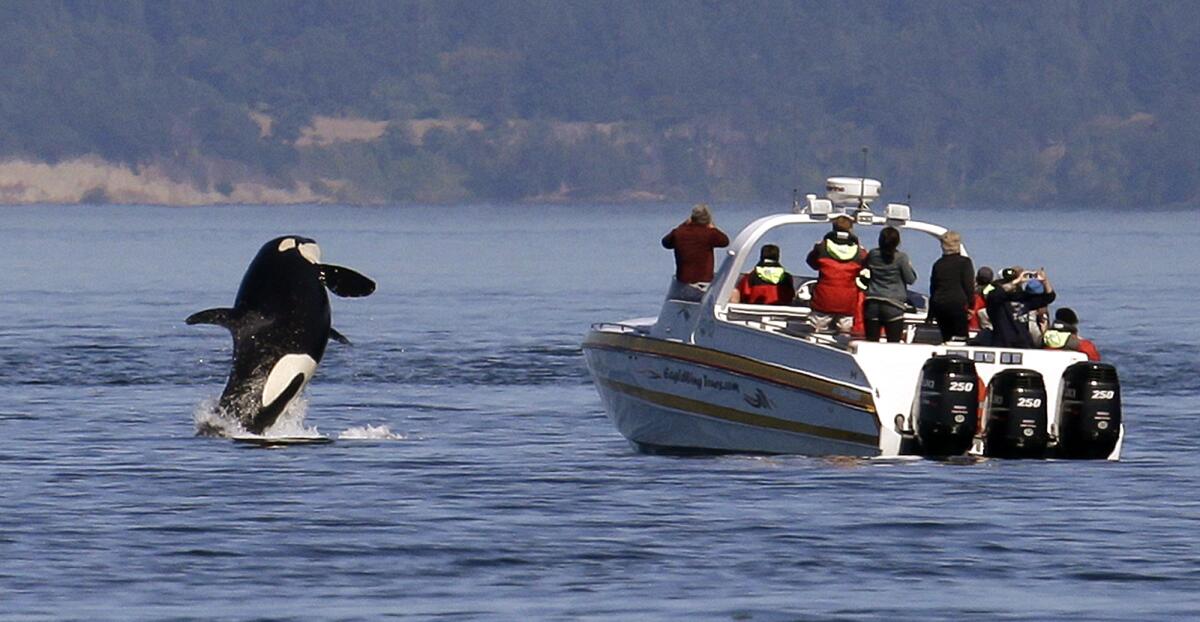
In this photo taken July 31, 2015, an orca whale leaps out of the water near a whale-watching boat in the Salish Sea in the San Juan Islands, Wash.
(Elaine Thompson / Associated Press)
David Tull of Mountain View casts his vote for the San Juan Islands.
“The San Juan Islands are beautiful. Period,” he writes. “The archipelago contains numerous islands of different sizes and accessibility. In places there are narrow channels between islands as well as open sea. The region is home to pods of orcas and gray whales and humpbacks. In addition, bald eagles are thriving in the islands. My biggest thrill was being out on the water in a small boat with orcas coming alongside. Tourism is the principal industry now, but the islands’ largest town, Friday Harbor, is not garish, schlocky or overrun.”
A coastal town on Canada’s Vancouver Island
Tyler Mark of Los Angeles was disappointed in us for overlooking Tofino, on Vancouver Island in British Columbia.
Writes Mark: “How you make a list without a visit to Tofino is beyond anyone who has been there. This small town perched on the tip of a peninsula on the west coast of Vancouver Island, with the Pacific and its whales on one side and its bay full of otters on the other, is a gem. White-capped mountains cascade down to redwood forests and an archipelago of small timbered islands with beautiful surfable beaches.” Mark also lauds Tofino’s food scene. Basically, he concludes, “This place has everything except easy access, which makes it more special.”

Lifestyle
Photos: 2026 Golden Globes Red Carpet

Ariana Grande arrives at the 83rd Golden Globes on Sunday, Jan. 11, 2026, at the Beverly Hilton in Beverly Hills, Calif.
Jordan Strauss/Invision/AP
hide caption
toggle caption
Jordan Strauss/Invision/AP
The brightest stars in TV and film kicked off the 83rd annual Golden Globes tonight in Beverly Hills, Calif. with Ariana Grande, Noah Wyle, Teyana Taylor and George Clooney are just some the names who walked the red carpet. This year’s ceremony was hosted by comedian Nikki Glaser.
Here’s a glimpse of what some of the attendees are wearing tonight.

Michael B. Jordan
Jordan Strauss/Invision/AP
hide caption
toggle caption
Jordan Strauss/Invision/AP

Ryan Coogler and Zinzi Evans
Frederic J. Brown/AFP/Getty Images
hide caption
toggle caption
Frederic J. Brown/AFP/Getty Images

Jean Smart
Jordan StraussInvision/AP
hide caption
toggle caption
Jordan StraussInvision/AP

Teyana Taylor
Jordan Strauss/Invision/Invision
hide caption
toggle caption
Jordan Strauss/Invision/Invision

Jenna Ortega
Jordan Strauss/Invision/AP
hide caption
toggle caption
Jordan Strauss/Invision/AP

Owen Cooper
Jordan Strauss /Invision/Invision
hide caption
toggle caption
Jordan Strauss /Invision/Invision

Sara Wells and Noah Wyle
Jordan Strauss/Invision/AP
hide caption
toggle caption
Jordan Strauss/Invision/AP

Claire Danes
Jordan Strauss/Invision/AP
hide caption
toggle caption
Jordan Strauss/Invision/AP

Stellan Skarsgård and Megan Everett-Skarsgard
Jordan Strauss/Invision/AP
hide caption
toggle caption
Jordan Strauss/Invision/AP

Amy Poehler
Jordan Strauss/ Invision/AP
hide caption
toggle caption
Jordan Strauss/ Invision/AP

EJAE
Jordan Strauss/Invision/AP
hide caption
toggle caption
Jordan Strauss/Invision/AP

Amanda Anka and Jason Bateman
Jordan Strauss/Invision/AP
hide caption
toggle caption
Jordan Strauss/Invision/AP

Paul Mescal
Jordan Strauss/Invision/AP
hide caption
toggle caption
Jordan Strauss/Invision/AP

Adam Brody and Leighton Meester
Jjordan Strauss/Invision/AP
hide caption
toggle caption
Jjordan Strauss/Invision/AP

Laufey
Jordan Strauss/Invision/AP
hide caption
toggle caption
Jordan Strauss/Invision/AP

Kirsten Dunst and Jesse Plemons
Jordan Strauss/Invision/AP
hide caption
toggle caption
Jordan Strauss/Invision/AP

Chris Olsen
Jordan Strauss/Invision/AP
hide caption
toggle caption
Jordan Strauss/Invision/AP

Lisa Ann Walter
Jordan Strauss/Invision/AP
hide caption
toggle caption
Jordan Strauss/Invision/AP

Macaulay Culkin and Brenda Song
Jordan Strauss/Invision/AP
hide caption
toggle caption
Jordan Strauss/Invision/AP
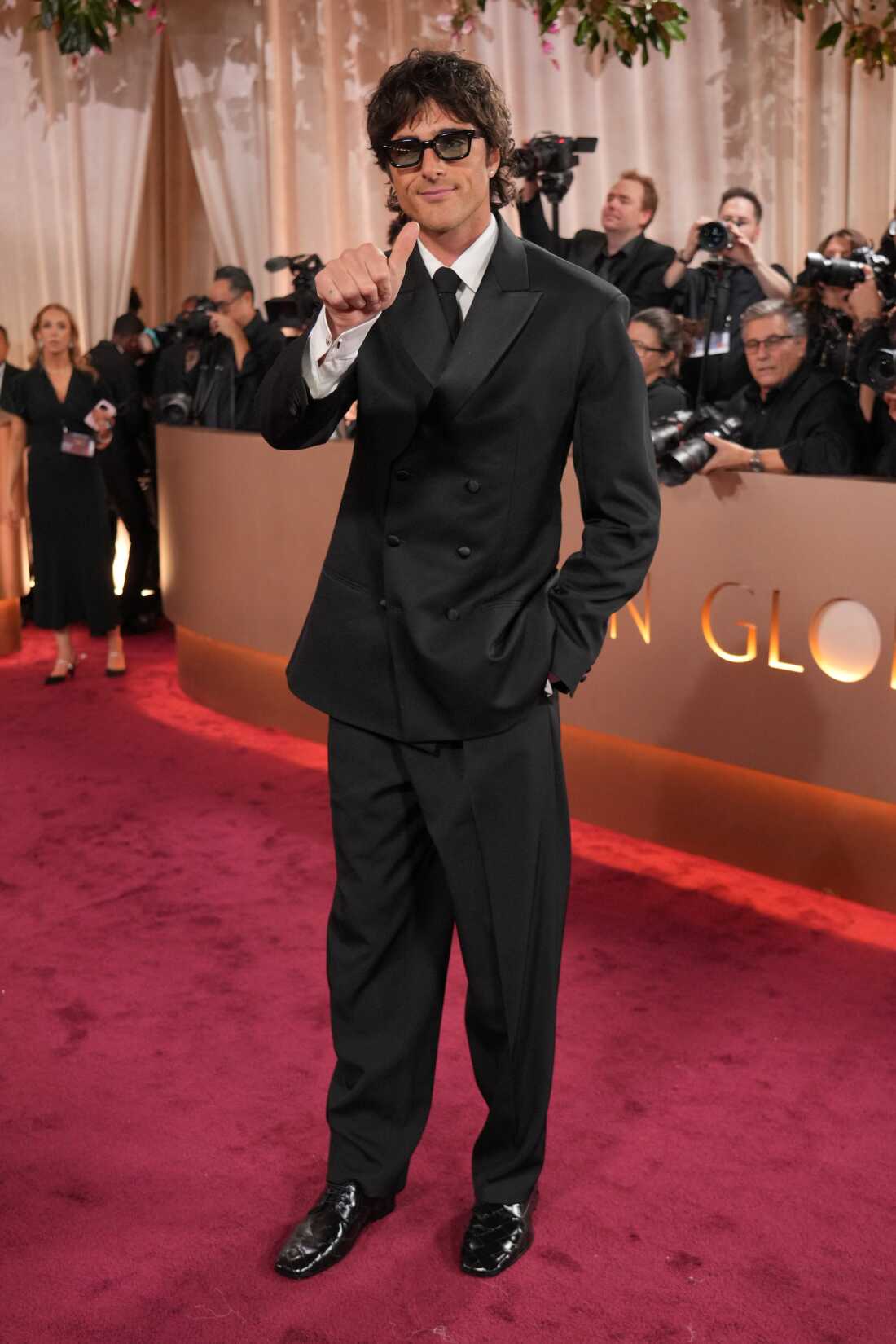
Jacob Elordi
Jordan Strauss/Invision/AP
hide caption
toggle caption
Jordan Strauss/Invision/AP

Selena Gomez and Benny Blanco
Jordan Strauss/Invision/AP
hide caption
toggle caption
Jordan Strauss/Invision/AP

Ryan Destiny
Jordan Strauss/Invision/AP
hide caption
toggle caption
Jordan Strauss/Invision/AP

Jennifer Garner
Jordan Strauss/Invision/AP
hide caption
toggle caption
Jordan Strauss/Invision/AP

Rose Byrne
Jordan Strauss/Invision//AP
hide caption
toggle caption
Jordan Strauss/Invision//AP

Kate Hudson
Jordan Strauss/Invision/AP
hide caption
toggle caption
Jordan Strauss/Invision/AP

Snoop Dogg
Jordan Strauss/Invision/AP
hide caption
toggle caption
Jordan Strauss/Invision/AP
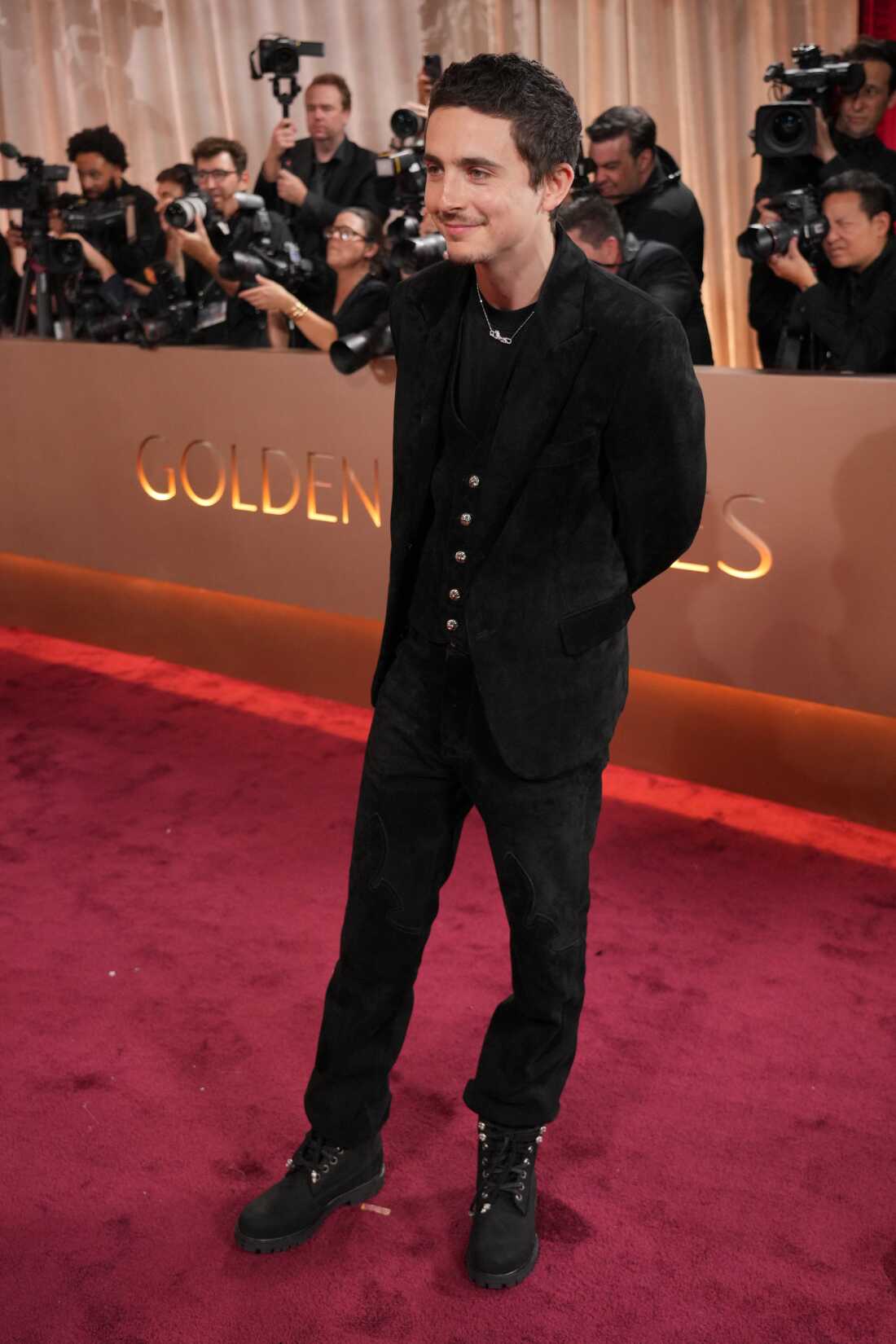
Timothée Chalamet
Jordan Strauss/Invision/AP
hide caption
toggle caption
Jordan Strauss/Invision/AP

Miley Cyrus
Jordan Strauss/Invision/AP
hide caption
toggle caption
Jordan Strauss/Invision/AP

George Clooney and Amal Clooney
Jordan Strauss/Invision/AP
hide caption
toggle caption
Jordan Strauss/Invision/AP

Leonardo DiCaprio
Jordan Strauss/Invision/AP
hide caption
toggle caption
Jordan Strauss/Invision/AP

Michel Martin
Jordan Strauss/Invision/AP
hide caption
toggle caption
Jordan Strauss/Invision/AP

Steve Inskeep
Richard Shotwell/Invision/AP/AP
hide caption
toggle caption
Richard Shotwell/Invision/AP/AP

Leila Fadel
Jordan Strauss/Invision/AP
hide caption
toggle caption
Jordan Strauss/Invision/AP
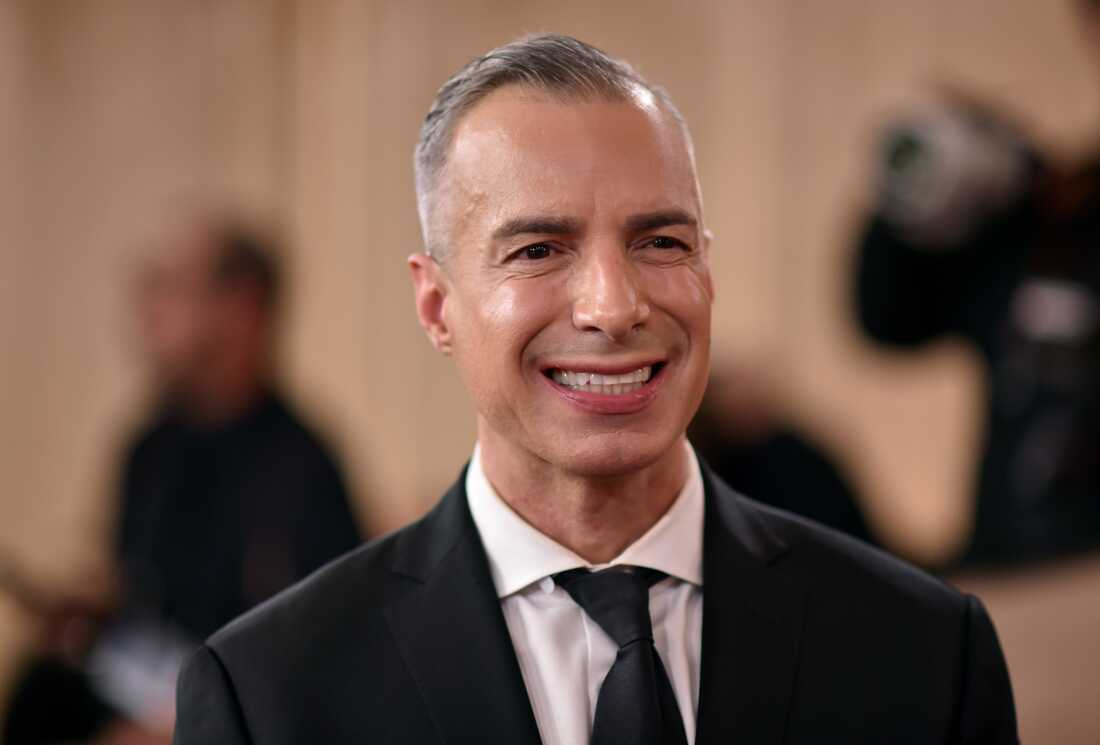
A Martinez
Richard Shotwell/Invision/AP
hide caption
toggle caption
Richard Shotwell/Invision/AP

Ben Falcone and Melissa McCarthy
Jordan Strauss/Invision/AP
hide caption
toggle caption
Jordan Strauss/Invision/AP

Amanda Seyfried
Jordan Strauss/Invision/InvisionAP
hide caption
toggle caption
Jordan Strauss/Invision/InvisionAP

William Stanford Davis
Jorden Strauss/Invision/AP
hide caption
toggle caption
Jorden Strauss/Invision/AP

Tessa Thompson
Jordan Strauss/Invision/AP
hide caption
toggle caption
Jordan Strauss/Invision/AP

Kathy Bates
Jordan Strauss/Invision/AP
hide caption
toggle caption
Jordan Strauss/Invision/AP

Dax Shepard and Kristen Bell
Jorden Strauss/Invision/AP
hide caption
toggle caption
Jorden Strauss/Invision/AP

Skylar Diggins
Jordan Strauss/Invision/AP
hide caption
toggle caption
Jordan Strauss/Invision/AP

Monica Padman
Jordan Strauss/Invision/AP
hide caption
toggle caption
Jordan Strauss/Invision/AP

Adam Scott and Naomi Scott
Jordan Strauss/Invision/AP
hide caption
toggle caption
Jordan Strauss/Invision/AP

Jayme Lawson
Jordan Strauss/Invision/AP
hide caption
toggle caption
Jordan Strauss/Invision/AP

Maya Rudolph and Paul Thomas Anderson
Gilbert Flores/Penske Media/Getty Images
hide caption
toggle caption
Gilbert Flores/Penske Media/Getty Images

Emma Stone
Jordan Strauss/Invision/AP
hide caption
toggle caption
Jordan Strauss/Invision/AP

Natasha Lyonne and Clea DuVall
Jordan Strauss/Invision/AP/AP
hide caption
toggle caption
Jordan Strauss/Invision/AP/AP

Nischelle Turner
Jordan Strauss/Invision/AP/AP
hide caption
toggle caption
Jordan Strauss/Invision/AP/AP

Brett Goldstein
Jordan Strauss/Invision/AP
hide caption
toggle caption
Jordan Strauss/Invision/AP

Parker Posey
Jordan Strauss/Invision/AP
hide caption
toggle caption
Jordan Strauss/Invision/AP

Vince Gilligan
Jordan Strauss/Invision/AP
hide caption
toggle caption
Jordan Strauss/Invision/AP

Chloé Zhao
Jordan Strauss/Invision/AP
hide caption
toggle caption
Jordan Strauss/Invision/AP

Mark Ruffalo and Sunrise Coigney
Jordan Strauss/Invision/AP
hide caption
toggle caption
Jordan Strauss/Invision/AP

Hannah Einbinder
Jordan Strauss/ Invision/AP
hide caption
toggle caption
Jordan Strauss/ Invision/AP

Sheryl Lee Ralph
Jordan Strauss/Invision/AP
hide caption
toggle caption
Jordan Strauss/Invision/AP

Keegan-Michael Key and Elle Key
Jordan Strauss/Invision/AP/AP
hide caption
toggle caption
Jordan Strauss/Invision/AP/AP

Justin Sylvester
Richard Shotwell/Invision/AP
hide caption
toggle caption
Richard Shotwell/Invision/AP

Judd Apatow and Lesley Mann
Jordan Strauss/Invision/AP
hide caption
toggle caption
Jordan Strauss/Invision/AP

Keltie Knight
Jordan Strauss/Invision/AP
hide caption
toggle caption
Jordan Strauss/Invision/AP

Sarah Snook
Jordan Strauss/Invision/AP
hide caption
toggle caption
Jordan Strauss/Invision/AP

Glen Powell
Jordan Strauss/Invision/AP
hide caption
toggle caption
Jordan Strauss/Invision/AP

Piper Curda
Jordan Strauss/Invision/AP
hide caption
toggle caption
Jordan Strauss/Invision/AP

Justine Lupe
Jordan Strauss/Invision/AP
hide caption
toggle caption
Jordan Strauss/Invision/AP

Helen Hoehne
Jordan Strauss/Invision/AP
hide caption
toggle caption
Jordan Strauss/Invision/AP

Natasha Rothwell
Jordan Strauss/Invision/AP
hide caption
toggle caption
Jordan Strauss/Invision/AP

Ashton Kutcher and Mila Kunis
Jordan Strauss/Invision/AP
hide caption
toggle caption
Jordan Strauss/Invision/AP

Minnie Driver
Jordan Strauss/Invision/AP
hide caption
toggle caption
Jordan Strauss/Invision/AP

Orlando Bloom
Jordan Strauss/Invision/AP
hide caption
toggle caption
Jordan Strauss/Invision/AP

Hudson Williams
Richard Shotwell/Invision/AP
hide caption
toggle caption
Richard Shotwell/Invision/AP

Connor Storrie
Jordan Strauss/Invision/AP
hide caption
toggle caption
Jordan Strauss/Invision/AP

Erin Doherty
Jordan Strauss/Invision/AP
hide caption
toggle caption
Jordan Strauss/Invision/AP

Wanda Sykes
Jordan Strauss/Invision/AP
hide caption
toggle caption
Jordan Strauss/Invision/AP

Nikki Glaser
Richard Shotwell/Invision/AP
hide caption
toggle caption
Richard Shotwell/Invision/AP

Julia Roberts
Jordan Strauss/Invision/AP
hide caption
toggle caption
Jordan Strauss/Invision/AP

Emily Blunt
Jordan Strauss/Invision/AP
hide caption
toggle caption
Jordan Strauss/Invision/AP

Chris Perfetti
Jordan Strauss/Invision/AP
hide caption
toggle caption
Jordan Strauss/Invision/AP

Rhea Seehorn
Jordan Strauss/Invision/AP
hide caption
toggle caption
Jordan Strauss/Invision/AP

Dakota Fanning
Jordan Strauss/Invision/Invision
hide caption
toggle caption
Jordan Strauss/Invision/Invision

Queen Latifah
Richard Shotwell/Invision/AP
hide caption
toggle caption
Richard Shotwell/Invision/AP
Lifestyle
Nikki Glaser Wears ‘Spinal Tap’ Hat to Tribute Rob Reiner at Golden Globes

2026 Golden Globes
Nikki Glaser Shouts Out Rob Reiner …
Dons ‘Spinal Tap’ Hat at Close of Show
Published
Rob Reiner wasn’t forgotten at this year’s Golden Globe awards … because host Nikki Glaser paid tribute to him just weeks after his murder.
Here’s the deal … during the sign-off for the awards show, Nikki came onstage wearing a black and white “Spinal Tap” hat — the band which serves as the subject of Reiner’s iconic 1984 mockumentary of the same name.
Worth noting … the Golden Globes do not typically air an in memoriam — so this was the only time Reiner was mentioned at the show.
As you know … Rob and his wife Michele Singer Reiner were found dead in their Los Angeles home last month. Their son Nick Reiner has been arrested for murder in connection to the case.
TMZ.com
Nick’s arraignment was scheduled for last week … but, his lawyer Alan Jackson dropped out of the case — leaving Nick with a public defender and new arraignment date set for late February.
Jackson told a gaggle of reporters outside the courthouse that Nick’s not guilty … but, he simply can’t defend him. He did not provide a reason for his withdrawal.
Our new documentary “TMZ Investigates The Reiner Murders: What Really Happened” dives into Rob and Michele’s grisly deaths … as well as Nick’s history of mental health issues and even how his weight gain set him on a dangerous path.
“TMZ Investigates The Reiner Murders: What Really Happened” is now streaming on Hulu.
Lifestyle
Sunday Puzzle: Pet theory

On-air challenge
Today’s puzzle is called “Pet Theory.” Every answer is a familiar two-word phrase or name in which the first word start starts PE- and the second word starts T-. (Ex. What walkways at intersections carry –> PEDESTRIAN TRAFFIC)
1. Chart that lists all the chemical elements
2. Place for a partridge in “The 12 Days of Christmas”
3. Male voyeur
4. What a coach gives a team during halftime in the locker room
5. Set of questions designed to reveal your traits
6. Something combatants sign to end a war
7. Someone who works with you one-on-one with physical exercises
8. Member of the Who
9. Incisors, canines, and premolars that grow in after you’re a baby
10. Nadia Comaneci was the first gymnast to score this at the Olympics
11. What holds the fuel in a British car
Last week’s challenge
Last week’s challenge was a numerical one from Ed Pegg Jr., who runs the website mathpuzzle.com. Take the nine digits — 1, 2, 3, 4, 5, 6, 7, 8, 9. You can group some of them and add arithmetic operations to get 2011 like this: 1 + 23 ÷ 4 x 5 x 67 – 8 + 9. If you do these operations in order from left to right, you get 2011. Well, 2011 was 15 years ago. Can you group some of the digits and add arithmetic symbols in a different way to make 2026? The digits from 1 to 9 need to stay in that order. I know of two different solutions, but you need to find only one of them.
Challenge answer
12 × 34 × 5 – 6 – 7 + 8 – 9 [or] 1 + 2 + 345 × 6 – 7 × 8 + 9
Winner
Daniel Abramson of Albuquerque, N.M.
This week’s challenge
This week’s challenge comes from listener Ward Hartenstein. Think of a well-known couple whose names are often said in the order of _____ & _____. Seven letters in the names in total. Combine those two names, change an E to an S, and rearrange the result to name another famous duo who are widely known as _____ & _____.
If you know the answer to the challenge, submit it below by Thursday, January 15 at 3 p.m. ET. Listeners whose answers are selected win a chance to play the on-air puzzle.
-

 Detroit, MI1 week ago
Detroit, MI1 week ago2 hospitalized after shooting on Lodge Freeway in Detroit
-

 Technology6 days ago
Technology6 days agoPower bank feature creep is out of control
-

 Dallas, TX4 days ago
Dallas, TX4 days agoAnti-ICE protest outside Dallas City Hall follows deadly shooting in Minneapolis
-

 Delaware3 days ago
Delaware3 days agoMERR responds to dead humpback whale washed up near Bethany Beach
-

 Dallas, TX1 week ago
Dallas, TX1 week agoDefensive coordinator candidates who could improve Cowboys’ brutal secondary in 2026
-

 Iowa6 days ago
Iowa6 days agoPat McAfee praises Audi Crooks, plays hype song for Iowa State star
-

 Montana2 days ago
Montana2 days agoService door of Crans-Montana bar where 40 died in fire was locked from inside, owner says
-

 Health1 week ago
Health1 week agoViral New Year reset routine is helping people adopt healthier habits




















